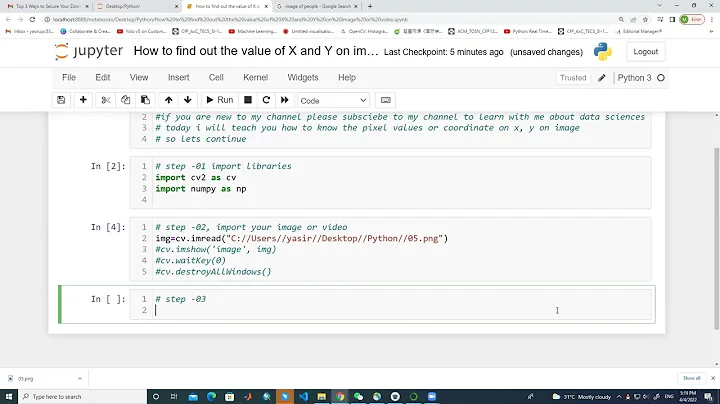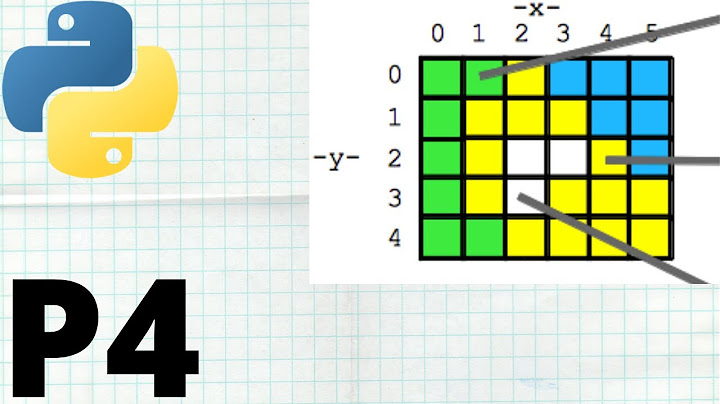Extract x,y coordinates of each pixel from an image in Python
Solution 1
Since the format you're showing seems to be pandas, I'll present the output with pandas, but you could just use a mere print. :)
I even included a n-dimension solution to your problem as comments.
import numpy as np
from itertools import product
arr = np.array([
list(range(300))
for _ in range(200)
])
print(arr.shape)
# (200, 300)
pixels = arr.reshape(-1)
""" n-dimension solution
coords = map(range, arr.shape)
indices = np.array(list( product(*coords) ))
"""
xs = range(arr.shape[0])
ys = range(arr.shape[1])
indices = np.array(list(product(xs, ys)))
import pandas as pd
pd.options.display.max_rows = 20
index = pd.Series(pixels, name="pixels")
df = pd.DataFrame({
"x" : indices[:, 0],
"y" : indices[:, 1]
}, index=index)
print(df)
# x y
# pixels
# 0 0 0
# 1 0 1
# 2 0 2
# 3 0 3
# 4 0 4
# 5 0 5
# 6 0 6
# 7 0 7
# 8 0 8
# 9 0 9
# ... ... ...
# 290 199 290
# 291 199 291
# 292 199 292
# 293 199 293
# 294 199 294
# 295 199 295
# 296 199 296
# 297 199 297
# 298 199 298
# 299 199 299
# [60000 rows x 2 columns]
Solution 2
Here is one very simple way to do that using Python/OpenCV, assuming I understand your question. Convert the image to grayscale and then use np.where().
import cv2
import numpy as np
# create red image
img = np.full((10,10,3), (0,0,255), dtype=np.uint8)
# convert to grayscale
gray = cv2.cvtColor(img,cv2.COLOR_BGR2GRAY)
# get coordinates (y,x) --- alternately see below for (x,y)
yx_coords = np.column_stack(np.where(gray >= 0))
print (yx_coords)
print ('')
# get coordinates (x,y)
xy_coords = np.flip(np.column_stack(np.where(gray >= 0)), axis=1)
print (xy_coords)
Returns for (x,y):
[[0 0]
[1 0]
[2 0]
[3 0]
[4 0]
[5 0]
[6 0]
[7 0]
[8 0]
[9 0]
[0 1]
[1 1]
[2 1]
[3 1]
[4 1]
[5 1]
[6 1]
[7 1]
[8 1]
[9 1]
[0 2]
[1 2]
[2 2]
[3 2]
[4 2]
[5 2]
[6 2]
[7 2]
[8 2]
[9 2]
[0 3]
[1 3]
[2 3]
[3 3]
[4 3]
[5 3]
[6 3]
[7 3]
[8 3]
[9 3]
[0 4]
[1 4]
[2 4]
[3 4]
[4 4]
[5 4]
[6 4]
[7 4]
[8 4]
[9 4]
[0 5]
[1 5]
[2 5]
[3 5]
[4 5]
[5 5]
[6 5]
[7 5]
[8 5]
[9 5]
[0 6]
[1 6]
[2 6]
[3 6]
[4 6]
[5 6]
[6 6]
[7 6]
[8 6]
[9 6]
[0 7]
[1 7]
[2 7]
[3 7]
[4 7]
[5 7]
[6 7]
[7 7]
[8 7]
[9 7]
[0 8]
[1 8]
[2 8]
[3 8]
[4 8]
[5 8]
[6 8]
[7 8]
[8 8]
[9 8]
[0 9]
[1 9]
[2 9]
[3 9]
[4 9]
[5 9]
[6 9]
[7 9]
[8 9]
[9 9]]
Solution 3
In your example, the pixel index order indicates row-major ordering. Given this, you can get the x and y values for any arbitrary pixel using the following function:
def idx_to_xy(idx):
'''
Assumes idx starts at one, as in the provided example
'''
x = (idx - 1) % 300
y = (idx - 1) // 300
return x, y
for px in [1, 2, 301, 302, 60000]:
x, y = idx_to_xy(px)
print("%5d %3d %3d" %(px, x, y))
# pixels x y
# 1 0 0
# 2 1 0
# 301 0 1
# 302 1 1
# 60000 299 199
Related videos on Youtube
fastlanes
Updated on June 04, 2022Comments
-
fastlanes almost 2 years
Let's say I have a color image that I've loaded into a numpy array of dimensions (200 x 300 x 3). In total, there are 60,000 pixels in the image. I'm trying to extract the width,height (x,y) coordinates of each pixel starting from the upper left top corner representing pixel 1 such that:
pixel# x y 1 0 0 2 1 0 . . 301 0 1 302 1 1 . . 60,000 299 199I'm tempted to use a for loop to do this in a more manual-nature but are there libraries or more effective ways to get those coordinate values for each pixel as such?
-
ALollz about 4 yearsIt's unclear to me where this begins. What exactly are you extracting? It seems like the above DataFrame could be created with 2 simple numbers X=300 and Y=200 and basically no other information. Is that the case?
-





